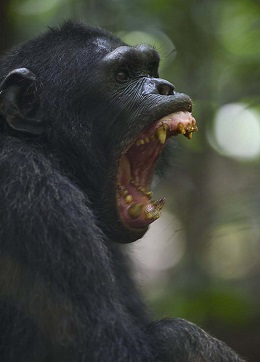Why chimps go ape
 Chimps are naturally violent, according to an international study involving experts at the University of St Andrews.
Chimps are naturally violent, according to an international study involving experts at the University of St Andrews.
In a new report, researchers dismiss previous claims that chimps adapted aggressive behaviour because of human interference. Instead, the study suggests that killing among chimpanzees – while rare – is a result of natural competition.
The findings of the research, published this week, could shed new light on our understanding of human violence and warfare.
St Andrews researchers Dr Catherine Hobaiter and Professor Klaus Zuberbühler contributed findings from their chimpanzee study site in Budongo, Uganda to the project.
Their data was then analysed alongside an Africa-wide study of a further 22 sites. Overall, the study compiled fifty years’ worth of information from 18 chimpanzee communities and four bonobo communities.
Dr Hobaiter commented, “Chimpanzees and bonobos are our closest relatives. By looking at the similarities and differences between their behaviour and ours we can start to trace the evolutionary origins of behaviours such as language, tool use or even violence and warfare.”
The study re-examines pioneering primatologist Jane Goodall’s reports of chimpanzee violence, which caught the attention of a global audience in the 1970s. Since then, scientists have argued whether chimps adapted to be violent through intergroup aggression, or because of human activities such as destruction of habitat.
However, the new research, led by the University of Minnesota and involving 29 co-authors, suggests that human impact, or even contact, isn’t the root cause of lethal aggression in chimps.
From the data spanning 50 years, only one suspected killing was observed in the bonobos, whereas 152 killings were reported in 15 chimpanzee communities. Variation in killing rates was unrelated to measures of human impact on those communities.
Killings increased in larger populations and groups with a high number of males, and most killings were carried out by males against other males from neighbouring groups, supporting the assumption that this behaviour is related to adaptive strategies.
Dr Hobaiter continued, “It was incredibly exciting to be a part of such a ground-breaking study. Within any one chimpanzee community these events are quite rare, so individually it is very hard to draw any systematic conclusions. Here, by combining decades of data from every major research site, we were finally able to start to answer some of the key questions about the origins of this fascinating behaviour.”
Professor Zuberbühler, co-author at the University of St Andrews, added, “For most biologists, our results were probably not too much of a big surprise, but the study finally puts an old and influential hypothesis to rest, which is, that animals are inherently good and that any lethal violence therefore must be due to human influence.
“What surprised me personally was that the ‘murder rate’ of chimpanzees is quite comparable to what is found in human societies, around 30 per 100,000 individuals per year. Currently, this corresponds roughly to the annual murder rate in Tijuana, Mexico.”
The study, published by Nature, was led by Dr Michael L Wilson of the University of Minnesota. He said, “Chimpanzees and bonobos are the two living species most closely related to us of all the animals alive today; we share the most in common in terms of genetics and evolutionary history. If we are using chimpanzees as a model for understanding human violence, we need to know what really causes chimpanzees to be violent.
“Based on our results, it’s clear that lethal aggression is something that chimpanzees naturally do. We found that chimpanzees sometimes kill other chimpanzees, regardless of whether human impacts are high or low, whereas bonobos were not observed to kill, whatever the level of human impacts.
“It’s still an open question whether this sort of violence is something has happened continuously in human evolutionary history, or whether it arose independently in humans and chimps. Perhaps our common ancestor, which we believe lived five to seven million years ago, also had high rates of violence, too.”
The paper is online at: http://dx.doi.org/10.1038/nature13727
ENDS
NOTE TO EDITORS:
THE RESEARCHER/S ARE AVILABLE FOR INTERVIEW:
Dr Hobaiter: 07762 816379 or email [email protected]
Professor Zuberbühler (TODAY, PM ONLY): 07546 447193 or email [email protected]
NOTE TO PICTURE EDITORS:
IMAGES ARE AVAILABLE FROM THE PRESS OFFICE – CONTACTS BELOW.
Issued by the Press Office, University of St Andrews
Contact Gayle Cook, Senior Communications Manager on 01334 467227 or email [email protected]
Ref: Going ape 190914
Category Research